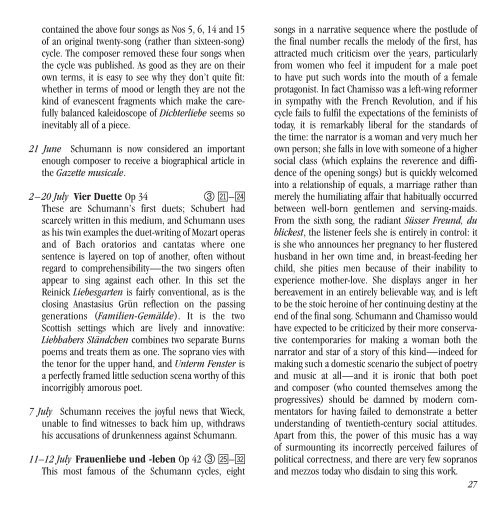Téléchargez le livret intégral en format PDF (application ... - Classique
Téléchargez le livret intégral en format PDF (application ... - Classique
Téléchargez le livret intégral en format PDF (application ... - Classique
Erfolgreiche ePaper selbst erstellen
Machen Sie aus Ihren PDF Publikationen ein blätterbares Flipbook mit unserer einzigartigen Google optimierten e-Paper Software.
contained the above four songs as Nos 5, 6, 14 and 15<br />
of an original tw<strong>en</strong>ty-song (rather than sixte<strong>en</strong>-song)<br />
cyc<strong>le</strong>. The composer removed these four songs wh<strong>en</strong><br />
the cyc<strong>le</strong> was published. As good as they are on their<br />
own terms, it is easy to see why they don’t quite fit:<br />
whether in terms of mood or <strong>le</strong>ngth they are not the<br />
kind of evanesc<strong>en</strong>t fragm<strong>en</strong>ts which make the carefully<br />
balanced ka<strong>le</strong>idoscope of Dichterliebe seems so<br />
inevitably all of a piece.<br />
21 June Schumann is now considered an important<br />
<strong>en</strong>ough composer to receive a biographical artic<strong>le</strong> in<br />
the Gazette musica<strong>le</strong>.<br />
2–20 July Vier Duette Op 34 3 cm–cp<br />
These are Schumann’s first duets; Schubert had<br />
scarcely writt<strong>en</strong> in this medium, and Schumann uses<br />
as his twin examp<strong>le</strong>s the duet-writing of Mozart operas<br />
and of Bach oratorios and cantatas where one<br />
s<strong>en</strong>t<strong>en</strong>ce is layered on top of another, oft<strong>en</strong> without<br />
regard to compreh<strong>en</strong>sibility—the two singers oft<strong>en</strong><br />
appear to sing against each other. In this set the<br />
Reinick Liebesgart<strong>en</strong> is fairly conv<strong>en</strong>tional, as is the<br />
closing Anastasius Grün ref<strong>le</strong>ction on the passing<br />
g<strong>en</strong>erations (Famili<strong>en</strong>-Gemälde). It is the two<br />
Scottish settings which are lively and innovative:<br />
Liebhabers Ständch<strong>en</strong> combines two separate Burns<br />
poems and treats them as one. The soprano vies with<br />
the t<strong>en</strong>or for the upper hand, and Unterm F<strong>en</strong>ster is<br />
a perfectly framed litt<strong>le</strong> seduction sc<strong>en</strong>a worthy of this<br />
incorrigibly amorous poet.<br />
7 July Schumann receives the joyful news that Wieck,<br />
unab<strong>le</strong> to find witnesses to back him up, withdraws<br />
his accusations of drunk<strong>en</strong>ness against Schumann.<br />
11–12 July Frau<strong>en</strong>liebe und -<strong>le</strong>b<strong>en</strong> Op 42 3 cq–dn<br />
This most famous of the Schumann cyc<strong>le</strong>s, eight<br />
songs in a narrative sequ<strong>en</strong>ce where the postlude of<br />
the final number recalls the melody of the first, has<br />
attracted much criticism over the years, particularly<br />
from wom<strong>en</strong> who feel it impud<strong>en</strong>t for a ma<strong>le</strong> poet<br />
to have put such words into the mouth of a fema<strong>le</strong><br />
protagonist. In fact Chamisso was a <strong>le</strong>ft-wing reformer<br />
in sympathy with the Fr<strong>en</strong>ch Revolution, and if his<br />
cyc<strong>le</strong> fails to fulfil the expectations of the feminists of<br />
today, it is remarkably liberal for the standards of<br />
the time: the narrator is a woman and very much her<br />
own person; she falls in love with someone of a higher<br />
social class (which explains the rever<strong>en</strong>ce and diffid<strong>en</strong>ce<br />
of the op<strong>en</strong>ing songs) but is quickly welcomed<br />
into a relationship of equals, a marriage rather than<br />
merely the humiliating affair that habitually occurred<br />
betwe<strong>en</strong> well-born g<strong>en</strong>t<strong>le</strong>m<strong>en</strong> and serving-maids.<br />
From the sixth song, the radiant Süsser Freund, du<br />
blickest, the list<strong>en</strong>er feels she is <strong>en</strong>tirely in control: it<br />
is she who announces her pregnancy to her flustered<br />
husband in her own time and, in breast-feeding her<br />
child, she pities m<strong>en</strong> because of their inability to<br />
experi<strong>en</strong>ce mother-love. She displays anger in her<br />
bereavem<strong>en</strong>t in an <strong>en</strong>tirely believab<strong>le</strong> way, and is <strong>le</strong>ft<br />
to be the stoic heroine of her continuing destiny at the<br />
<strong>en</strong>d of the final song. Schumann and Chamisso would<br />
have expected to be criticized by their more conservative<br />
contemporaries for making a woman both the<br />
narrator and star of a story of this kind—indeed for<br />
making such a domestic sc<strong>en</strong>ario the subject of poetry<br />
and music at all—and it is ironic that both poet<br />
and composer (who counted themselves among the<br />
progressives) should be damned by modern comm<strong>en</strong>tators<br />
for having fai<strong>le</strong>d to demonstrate a better<br />
understanding of tw<strong>en</strong>tieth-c<strong>en</strong>tury social attitudes.<br />
Apart from this, the power of this music has a way<br />
of surmounting its incorrectly perceived failures of<br />
political correctness, and there are very few sopranos<br />
and mezzos today who disdain to sing this work.<br />
27



